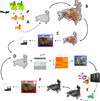Prediction and Prevention of Parasitic Diseases Using a Landscape Genomics Framework
- PMID: 27863902
- PMCID: PMC5376512
- DOI: 10.1016/j.pt.2016.10.008
Prediction and Prevention of Parasitic Diseases Using a Landscape Genomics Framework
Abstract
Substantial heterogeneity exists in the dispersal, distribution and transmission of parasitic species. Understanding and predicting how such features are governed by the ecological variation of landscape they inhabit is the central goal of spatial epidemiology. Genetic data can further inform functional connectivity among parasite, host and vector populations in a landscape. Gene flow correlates with the spread of epidemiologically relevant phenotypes among parasite and vector populations (e.g., virulence, drug and pesticide resistance), as well as invasion and re-invasion risk where parasite transmission is absent due to current or past intervention measures. However, the formal integration of spatial and genetic data ('landscape genetics') is scarcely ever applied to parasites. Here, we discuss the specific challenges and practical prospects for the use of landscape genetics and genomics to understand the biology and control of parasitic disease and present a practical framework for doing so.
Copyright © 2016 Elsevier Ltd. All rights reserved.
Figures
References
Publication types
MeSH terms
Grants and funding
LinkOut - more resources
Full Text Sources
Other Literature Sources
Medical
Miscellaneous



